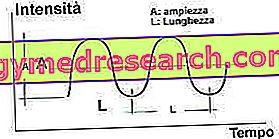Generality
Pediatric unblocking maneuvers are gestures that can save the lives of children who accidentally ingest or inhale foreign bodies (peanuts, sweets, coins, toy pieces, etc.). In fact, small objects or food can obstruct the airways in a partial or complete manner.

During childhood, suffocation from ingestion or inhalation of a foreign body is, unfortunately, a fairly frequent event, especially in the age group between 6 months and 3 years . Children are more subject to this type of accident due to the incomplete maturity of the reflex coordination mechanisms and the reduced diameter of their airways.
Among the foods that most often make the practice of pediatric unblocking maneuvers necessary, there are the grapes, the pieces of carrot, the cured ham, the wurstel and the cherry tomatoes.
Pediatric unblocking maneuvers must be carried out if the child has a sudden respiratory crisis with cyanosis or cough, following the ingestion of a food or inhalation of an object. The consequences of airway obstruction can be severe and can sometimes be fatal.
For this reason, the rapid recognition of the signals associated with suffocation and the correct execution of pediatric unblocking maneuvers are of fundamental importance. Having assessed the child's condition, therefore, it is important to know if and how to act: sometimes, improper intervention can aggravate a non-critical situation.
What are
Pediatric unblocking operations are a sequence of operations to be performed in the event of airway obstruction.
Choking is often a consequence of large pieces of food, candy or small objects that can be easily swallowed whole, going to obstruct the airways in a few seconds. Inhalation of foreign bodies may instead result from simultaneous actions of the child, such as talking or laughing at mealtimes or during play.
Causes
Suffocation due to ingestion or inhalation of a foreign body is one of the main causes of accidental death in childhood (especially in children under the age of 3), in the home or in schools. For this reason, knowing the pediatric unblocking maneuvers is useful to avoid the degeneration of the event.
What is suffocation and why it occurs
In pediatric age, suffocation is an accidental and potentially dangerous event, characterized by the passage of a foreign body in the respiratory tract.
These episodes can occur while children eat or play with small objects; in fact, it is necessary to consider that, in the course of early childhood, the knowledge of the surrounding world initially passes through the mouth.
Once inhaled, foreign bodies can obstruct the airways either partially or completely .
Who is most affected
In Italy, more than 50 children a year lose their lives due to airway obstruction, which is secondary to inhaling foreign bodies or food.
Suffocation is a possible accident at any age, but is more frequent among infants up to 12 months of life and in children between 1 and 4 years old.
This particular " predisposition " is due to some typical characteristics of the psychophysical development and physiology of the respiratory tree in pediatric age, that is:
- Small diameter airways;
- Poor coordination between chewing and swallowing solid foods;
- Incomplete dentition;
- High respiratory rate;
- Tendency to perform multiple activities at the same time (for example, children eat while they run, play, talk or watch TV).
It should be noted that the danger of suffocation remains high up to 14 years of age.
What objects are dangerous?
Regarding the suffocation of children, the foods most at risk have particular characteristics:
- Size : both small foods that are difficult to manage during chewing (eg seeds) and those that are too large (eg large pieces of raw vegetables that risk ending up in the airways before the child is able to bite them) are dangerous;
- Shape : the washers (eg sliced carrots and frankfurters) or round foods (eg cherries, grapes, peanuts, pistachios, mozzarella balls) are particularly risky, as they can slip into the airways, before the child is able to bite them, blocking hypopharynx;
- Consistency : attention must be paid to hard and fibrous foods (eg celery, fennel and greasy ham); sticky and soft foods can also be dangerous (eg marshmallows and spreads).
The foods most at risk include:
- Grapes;
- Carrot;
- Raw ham;
- sausages;
- Cherry tomatoes;
- Seeds and popcorn;
- Dried fruits, such as pistachios and hazelnuts;
- Candies, especially round and large or rubbery ones.
Among the objects to watch out for when a child under 4 is at home are:
- Removable toys;
- Stacks and magnets;
- Pen stoppers;
- Balls of all types and materials;
- Coins;
- Pendants and buttons.
Symptoms and Complications
Pediatric unblocking operations must be implemented promptly when the child shows signs of suffocation, ie:
- He can't talk, cry or scream;
- The face is pale or bluish (cyanotic) due to the lack of oxygen (anoxia).
- If he is able to do so, bring your hands around your neck (defense reflex).
During choking, breathing is difficult and produces a high-pitched noise.
Pediatric obstruction maneuvers: partial and complete obstruction
To correctly implement the pediatric unblocking maneuvers it is necessary, first of all, to distinguish the partial obstruction from the complete one:
- Partial obstruction : the foreign body is in a position to allow a minimum passage of air, which is still sufficient to oxygenate the blood. The child is able to cough and cry.
- Complete obstruction : the foreign body creates a sort of "plug" in the airways that prevents the passage of air. Therefore, the child is no longer able to cough or cry and is unable to make any sound.
Complete obstruction represents an emergency that deserves immediate intervention because, if it is not rapidly resolved, it leads to respiratory failure and cardiac arrest in a few minutes.
What to do
To avoid irreparable consequences, before a child who has ingested or inhaled a foreign body, the parent must understand when and how to intervene correctly and in what order. In any case, it is important to promptly alert 118 and, even in the sole doubt of suffocation, the child must be evaluated in the Emergency Department.
Partial obstruction
In the case of partial obstruction of the airways, the child must be assisted and encouraged to cough vigorously and spontaneously, without any interference (note: the cough reflex indicates the presence of a passage, albeit minimal, of air) . Exercising blows or slaps on the back or shoulders could aggravate the situation, as it can contribute to the displacement of the foreign body, risking to completely obstruct the passage of air.
Therefore, if the child is conscious, he cries, can talk and / or cough, nothing needs to be done.
Partial obstruction: synthetic pediatric unblocking maneuvers
How to recognize it
The child is able to cough, cry and talk.
What to do
- AVOID any unblocking maneuver;
- Calm the baby and encourage him to cough.
If the clinical picture does not resolve, call 118 or carry the child to the nearest emergency room.
Complete obstruction
However, if complete airway obstruction occurs, parental intervention is essential. In this case, pediatric unblocking maneuvers can save the child's life (if properly performed).
Pediatric unblocking maneuvers vary according to the age of the patient.
Pediatric unblocking maneuvers - Newborn or Infant (up to 1 year of life)
In the event of complete obstruction, there are two maneuvers to clear the airways:
- Interscapular patches :
- The rescuer must uncover the child's back and place him in a prone position (on his stomach), straddling his own forearm or thigh, so as to create a rigid plane.
- Keep the head slightly extended and lower than the trunk.
- Place the forearm on the thigh.
- With your free hand, exercise 5 vigorous strokes in the interscapular area with a lateral escape route, ie taking care not to hit the head.
- Chest compressions :
- The rescuer must grasp the child's neck and lie down on his back (on his back) on the other forearm, again to create a rigid plane.
- At the level of the landmark (middle lower third of the sternum), perform a vigorous compression every 3 seconds, 5 times (note: the technique is the same as cardiopulmonary resuscitation). For this series of gestures two fingers are used, taking care to keep the head still and in position.
These two pediatric unblocking maneuvers must be alternated until complete obstruction is resolved . If the child becomes unconscious, waiting for the paramedics, it is necessary to place the patient supine on a rigid plane and proceed with basic cardiopulmonary resuscitation .

Pediatric obstruction maneuvers - Older child (over 1 year of life)
In children older than one year, interscapular strokes (as for the infant) are alternated with the Heimlich maneuver, until the foreign body is expelled.
This airway disobstruction procedure is also valid in adults and is performed with the patient standing or sitting .
- Heimlich maneuver:
- The rescuer stands behind the child, then wraps his waist with both arms. The hands are placed one above the other, closed in a fist, between the lower end of the sternum and the navel.
- Perform vigorous compressions on the abdomen, which have an anterior-posterior direction (that is, pushing the child towards him) and caudo-cranial direction (from bottom to top). The aim is to obtain an "artificial" cough, exploiting the residual air in the lungs.
The Heimlich maneuver must be continued until the complete obstruction is resolved or until the patient becomes unconscious .
What to do if the child is unconscious
If the situation is not resolved despite the pediatric unblocking maneuvers and the child becomes unconscious, it is important:
- Position the patient supine on a rigid surface;
- Perform the basic cardiopulmonary resuscitation, summarized as follows:
- In the absence of respiratory activity: 5 ventilations (Mouth / Mouth-Nose in the infant; Mouth / Mouth in the child);
- If the signs of circulatory activity are not present: 30 chest compressions (technique of 2 fingers in the infant);
- Continue alternating 30 compressions with 2 ventilations for 3 cycles (about 1 minute).
Resuscitation maneuvers must continue until the vital signs reappear or help arrives (118).
Complete obstruction: summary pediatric unblocking maneuvers
How to recognize it
The child is NOT able to cough or cry or speak.
What to do
- Ask for help and have the emergency number activated with extreme urgency by calling 118.
- Immediately carry out pediatric unblocking maneuvers:
- 5 interscapular shots with a side escape route;
- 5 slow and deep chest compressions (in the middle of the sternum, using two fingers, in the infant; Heimlich maneuver in the child).
- Continue to alternate the maneuvers until the foreign body is expelled.
- If the child becomes unconscious:
- Place on a rigid surface;
- Remove the foreign body only if surfacing;
- Ensure airway patency;
- Perform cardiopulmonary resuscitation (CPR).
What NOT to do
In the event of airway obstruction it is essential that the parent remains calm to carry out, in the correct sequence, the pediatric unblocking maneuvers. Panicking can only worsen a critical situation.
Furthermore, it is appropriate:
- Do not shake the child who is suffocating (the risk is to push the foreign body lower);
- Do not put your fingers in the child's throat to induce vomiting;
- Do not try to remove the foreign body from the oral cavity: you risk inducing the passage of the object from the alimentary pathways to the respiratory ones, a much more serious event.
Did you know that…
Municipalities, hospitals and schools organize numerous free courses to inform parents about the risk of suffocation and to teach them the correct manners of pediatric unblocking.
How to prevent choking in children?
To minimize the risk of suffocation, important precautions can be taken:
- Never leave children alone while eating, especially if they are very small and weaning is in progress;
- The child must eat at the table, sitting with his back straight, avoiding distractions (do not give food while playing or watching TV);
- Do not feed the baby when it is agitated or while laughing or crying;
- Don't force the child to eat;
- Prepare and cut the foods most at risk in the right way, to change the shape, consistency and size, so that they do not get stuck in the throat (eg chop the cylindrical food into strips; eliminate ribs and filaments; chop or grate etc.) ;
- Do not give children up to 4 years of age: nuts and seeds (not recommended due to the high risk of aspiration associated with them), sweets and chewing gum;
- Encourage the child to eat slowly, to take small bites and chew well before swallowing.



